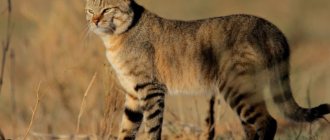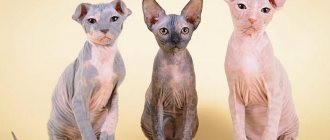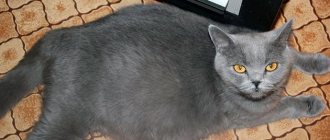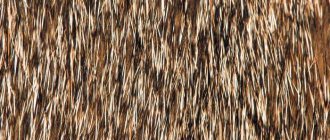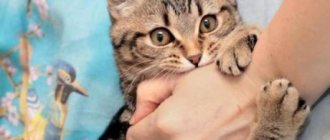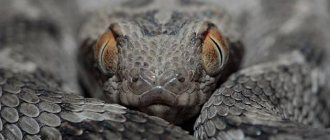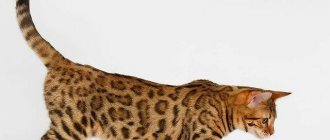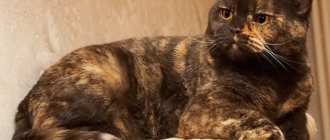The sand cat is the smallest representative of wild cats. This cautious hunter was first described in the mid-19th century by a French naturalist who was part of the expedition of Jean Auguste Marguerite. The sand cat was discovered among the sands of the Sahara, and at the beginning of the 20th century in the deserts of Central Asia.
The sand cat has an extraordinary appearance, which makes it a desirable pet for exotic lovers. Because of their willingness to pay a lot of money for a touching animal, desert predators often become targets for poachers.
Details
Features of Mau appearance
The current standard for the Arabian Mau cat breed gives the following description of the standard:
- The head is wedge-shaped, with an elongated profile with a defined chin and moderately pronounced whisker pads. The forehead is narrow, flat in shape, the nose is of medium length.
- Large oval shaped eyes. The iris of any shade should be in harmony with the color of the coat.
- The ears are large, set wide and at an angle. There are no tassels, the inner edge is moderate.
- The body is dry, muscular, all lines are toned. Strong neck of medium length.
- Long legs, straight and well muscled. The pads of the limbs are elongated.
- The tail is wide, the length should be equal to the length of the body.
- The coat is short without undercoat. The fur is hard to the touch. Kittens are born with an elongated pile, which by the age of one year completely changes to an adult short one.
- Any color, but most often corresponds to the Van variant - white body and red limbs and spots.
As for size, the breed falls into the medium category. Cats are always smaller than males, weighing up to 6 kilograms. A cat can grow up to 8 kilograms.
IMPORTANT: individuals with soft fur and an excessively graceful body can be excluded from breeding.
Individual characteristics of character and habits
The most important characteristic of the breed is that they are hunter cats. The wild roots are so close that not one of the titled exhibition representatives of the breed has yet lost their talent for tactical extermination of mice on their territory. It is ideal to keep the breed in the house and give it the opportunity to walk in the territory at any time of the day.
The second advantage of the proximity of aboriginal roots is a flexible mind. If you start training a kitten on time, you can achieve very good results by the age of one year. Even the basic commands of a dog training course are within the capabilities of the breed.
The Arabian cat breed becomes attached to the family very quickly. The cat usually doesn’t have favorites; she gets along and is affectionate with everyone, including children. Can live with dogs.
Many owners note the breed's silence
Again, the habit of not making sounds is directly related to the long residence of the breed’s ancestors on city streets, where attracting attention with one’s voice is useless, and more often than not, simply dangerous.
The breed treats guests with interest. In general, for the Arabian Mau, a change of environment is not a problem. You can easily take your pet with you on trips.
House maintenance - how to organize daily life for the breed
The Arabian Mau breed is self-sufficient and largely independent. It does not require any special conditions; it is enough to maintain minimal external hygiene and create a balanced diet.
There are only a few aspects of nutrition that need to be considered to keep the breed healthy. Firstly, the breed is omnivorous, but this does not mean that you can give everything that is left from your table. A regular cat diet of dry, wet or natural food is suitable for the breed.
The second point in matters of nutrition is to avoid overeating. Watch portion sizes and monitor your pet's weight. Due to the fact that for centuries the Mau have been getting food for themselves, spending a lot of energy on it, at home, with plenty of feeding, they easily become obese.
Hygiene with the breed is not difficult. Coarse wool is brushed with a special brush once a week. After combing, you can walk with a damp towel to collect dust and dirt. This procedure will also help to bathe the Mau as rarely as possible, because the desert cat’s skin has an extremely negative attitude towards water.
Rubbing the eyes, ears and brushing teeth can be done as they become dirty, but it is better to accustom the cat to these procedures every other day.
The breed requires veterinary support once a year, unless specific cases of disease arise. Mau immunity is strong, timely vaccination and routine examinations can protect them from most diseases.
Purchasing kittens
The nearest breed kennel is located in Dubai. It is there that you can easily buy Arabian Mau kittens for only 60,000 rubles apiece.
The most famous and authoritative kennel belongs to the founder of the exhibition version of the breed, Petra Müller. The price for a kitten from it will be significantly higher.
Unfortunately, the breed is historically valuable, but has little competitiveness among many other cat breeds. Natural agility and fighting character are not supported by any expressive features of appearance, so the conquest of the world is very slow.
Sand cat at home
The sand cat is an expensive pet. Prices on the underground market start at $6,000. This is a wild animal, not adapted to life at home. If an exotic lover is determined to financially support poaching, then he should provide the animal with proper care and education:
- a humidity level that is comfortable for humans will have a bad effect on the health of a pet that prefers the drought of the desert;
- temperature changes are unacceptable for an inhabitant of a consistently hot climate;
- requires a lot of open space;
- the sand cat is an active predator, so it is necessary to create a place for playing and climbing at home;
- The desert hunter’s immunity is not adapted to other conditions, so it must be protected from diseases and observed by a veterinarian.
The rules of upbringing are the same regardless of whether the dune kitten is wild or domestic - they should be accustomed to the tray, given attention and affection. Playing with hands or feet is unacceptable, because an adult animal will continue to “hunt” them.
As a punishment, instead of screaming and spanking, it is better to use a spray bottle of water. The breeder must always remember that the sand cat is an animal with character.
Character and behavioral characteristics
The main feature of the character of the Arabian Mau, like all aboriginal breeds, is attachment to the “pack,” that is, the family, and the “leader,” that is, the owner. Mau are ready to zealously, like dogs, protect their household from everything that seems dangerous to them. Despite such fanatical devotion, Mau show themselves to be quite independent and proud cats, which does not prevent them from basking on their owner’s lap from time to time.
The origin of the Mau left a considerable imprint on his character. These cats are natural hunters and excellent mousecatchers. Moreover, they bring all their prey to the “flock,” which may not please squeamish and sensitive people. By nature, Mau are unusually active. If you do not give them the necessary physical activity, they can create an unimaginable mess in the apartment.
Mau is very attached to his owner
Mau are explorers. They will not leave a single corner of their territory without their attention. They can easily climb the tallest cabinets. The owner of the Mau should be concerned about his safety: the fearless cat will jump from the tenth floor without hesitation. Therefore, if you live in an apartment, there should be protection on the windows.
Another feature of the Mau is the need for personal space. The more there is, the happier the Mau. The ideal home for such cats is a spacious country house with a garden plot. Mau cats are much more active at night. But if you take a small kitten into your home, over time it will adapt to the daytime routine.
In nature, Mau are nocturnal
Mau are one of those cats that are not afraid to be allowed to roam freely
Noble desert beauties will never allow themselves to get involved in a fight, they will behave prudently and carefully. They will never get lost on the way home thanks to their unusually developed sense of smell, ability to navigate in space and memory
But still, with such free walks, even one cat is not immune from danger (dogs, people who are cruel to animals, etc.). Therefore, if you are afraid to let your pet out alone, do not be lazy to walk him on a leash. Mau once every two days is enough for a comfortable life.
Mau have an excellent memory
Also, the Mau will not bother busy people. These self-sufficient cats feel equally at home both in a large noisy family and in the company of a lonely, busy person. They tolerate loneliness very well. The main thing is that they have something to do and play with, since the worst thing for Mau is boredom.
As for his attitude towards children, everything depends only on them. Mau will only get along with the child who respects him. It is unacceptable to pull a Mau by the tail, ruffle his ears, and even more so obsessively follow him, caress him against his will and force him to do anything. The first time, the Mau will limit himself to a warning hiss, and the next time, without a twinge of conscience, he will use his claws and teeth. Therefore, it is not recommended to take the Arabian cat into a family with children under 10 years of age.
Before bringing a pet into the house, it is very important to explain to the child that a cat is a living creature that also has the right to peace of mind and choice. Only in this case the Mau will become a true devoted friend to the little owner.
Arabian Mau get along well with dogs
Among animals, the Mau builds the most friendly relationship, oddly enough, with dogs. Other cats are difficult to tolerate, especially male cats. And birds and rodents are perceived exclusively as a snack.
Mating and choosing a kitten
Breeding Arabian Mau is permitted only in specialized nurseries for experienced breeders. This is due to the fact that the breed is considered rare. However, oddly enough, Mau is allowed to crossbreed with outbred shorthaired cats.
In order not to make a mistake in choosing a kitten, it is better to go to their homeland, to the UAE, to the Muller nursery.
These desert beauties in the UAE even live on the streets, so you can safely take home a wild one. However, taming a wild animal is much more difficult than raising a kitten taken from a nursery. The Mau's distinctive features are a muscular body, smooth fur, long thin limbs, and large ears.
A healthy baby's ears and eyes should not fester, the tummy should be soft and not swollen, there should be no wounds, the fur should be smooth and shiny. The cub itself is playful, active and curious.
Breed standard
The felinological European WCF system gives the following description of the reference specimens of the Arabian Mau.
Head
It has the shape of a rounded modified wedge. The profile is elongated, the chin is well formed, the whisker pads are moderately developed. Short nose. The forehead is flat and narrow.
Eyes
Large, oval-shaped, not very widely spaced. The color matches the coat color. Preference is given to clear and pure shades.
Ears
Quite large, widely spaced and located slightly at an angle to the base of the skull. Gradually taper to a rounded tip. They have an internal and small external edge.
Wool
Short and stiff, lying close to the body. There is no undercoat. Finer and softer hair is acceptable in kittens up to 18 months.
Color
Numerous and varied. The most common, also characteristic of the Turkish Van, is red with white spots.
Red with white
Solid colors (i.e. solid, uniform) are extremely rare, for example, anthracite-black (it should not have a rusty tint), pure snow, red (red), brown, gray. Bicolor, tabby (with spots or stripes), and tortie (tortoiseshell) colors are also common.
Anthracite-black Pure snow Two types of red Mau tabby
Silver with spots
Only intrabreeds. Read about mating cats and female cats.
Disqualification criteria
Animals are not accepted to participate in exhibitions with the following deficiencies:
- excessive thinness;
- weak limbs;
- too graceful physique;
- excessively delicate and silky wool;
- small sizes.
Photo gallery of Arabian Mau:
Appearance
The close relationship between the Arabian Mau and wild cats has made the pets strong, hardy and muscular animals. The standard does not allow thinness, small build, weak paws or thin bones. The breed is similar to oriental cats, but looks more proportional and strong, which is noticeable even in the photo. The obvious similarity is the elongated and flexible body. The WFC standard includes a description of breed characteristics and will most likely be further developed if the Arabian Mau receives championship status.
The head is rounded, slightly disproportionate in width. The forehead is narrow and almost flat. The cheeks and cheekbones are not prominent, the cheekbones are rounded and taut. The chin is medium but noticeable. Transition from nose to forehead with a slight curve, but without a sharp angle. The nose pad and chin form a straight line.
The ears are high, wide, slightly turned back. Planted close and high. The auricle is deep and covered with fur.
The eyes are oval or round, expressive, set close to the bridge of the nose. Any color, but in harmony with the wool palette.
The body is strong, elongated, muscular. Visually, the cat looks well-fed, but obesity is not allowed. The muscles can be clearly felt under the fur. The chest is flat but muscular.
Paws are long and powerful. The hand is oval, collected, the claws are well developed, especially on the hind legs.
The tail is long, mobile, flexible, tapering towards the tip.
The coat is short, close-lying, not smooth, lacking down, and hard. The standard allows a single color or pattern (bicolor, merkel, tabby), and the amount of white is also not limited. The color palette includes the following main coat colors:
- Plain white and black.
- Grey. Red (red).
- Brown.
Description of the breed
Arabian or Arabian Mau are descendants of wild desert cats that lived in the countries of the Arabian Peninsula, in the valley of the Tigris and Euphrates rivers. These four-legged animals were also found in South-West Asia. There is a version that they were specially tamed by Asian nomadic tribes in order to protect supplies from rodents. The closest relatives of the species are the Egyptian Mau, the same ones that were so revered by the ancient inhabitants of the country of pyramids and camels.
This is a breed of natural origin, so their position among the feline elite is controversial and ambiguous. Animals began to be bred quite recently (about 13 years ago, in 2004), but cats were never officially accepted into the community. Although they are allowed to participate in exhibitions, they do not have the right to claim first place.
Striped beauties tolerate heat well and have the appropriate physique, which allows them to survive in dry conditions and high temperatures. The mustaches are very sophisticated and have a balletic grace. This build was given to them for a reason. The absence of excess weight and a thin, strong skeleton affect the internal thermoregulation of the animal’s body, helping to be agile and fast in the desert: not to get stuck in the sand while hunting and not to miss the prey. Purrs love to bask in the sun and can spend whole days on the window or in the sunny part of the room.
Cats have a characteristic appearance that they inherited from their desert ancestors:
- Elongated triangular muzzle.
- Slanted, “Asian” olive-colored eyes.
- Light build, muscular build.
- Uniform thin stripes on the coat.
- Long tail with a thin tip.
The color of this type of cat is very diverse. There are gray, silver, red and even black maus! Those with dark fur also have tiger stripes on their backs, and they are clearly visible. The stripes can be “blot-shaped”, and sometimes they are full-fledged spots, characteristic of the tabby color. The color of the classic representatives of the breed is khaki, typical for inhabitants of desert areas - sand with a yellowish tint, sometimes beige and light brown.
The coat has a special structure that helped cats not sweat and overheat, providing ventilation while running. They have no undercoat; it is easy to feel the skin under the fur. Arabian purrs are reliably protected by nature from heat stroke. The fur is very delicate and soft to the touch, reminiscent of corduroy, velvet or silk, although it becomes coarser with age.
Mau look fragile and skinny, but this is only at first glance. They are actually very strong. Lean and ferocious - this is about representatives of this species. Cheetah in miniature!
Breeding work
The parental instincts of this breed are highly developed - so much so that many cats help cats during childbirth, and then take on part of the responsibilities of raising the younger generation. For representatives of the cat family, such behavior is very rare. But for the owners, watching the relationships in a large family of Egyptian Mau is a great pleasure.
Preparation and carrying out mating
If you are the happy owner of a breeding cat, prepare it for mating in advance. Egyptian Mau, like all cats of aboriginal origin, mature quite early, so the animal can be bred already on the third heat. A mandatory requirement for admission to breeding is participation in club shows and receiving high breeding ratings at them.
On the eve of the intended mating, both producers are required to undergo an examination by a veterinarian. Future parents must be promptly vaccinated and treated against all types of parasites.
Correct selection of sires is the basis of breeding work
The cat for mating is brought to the cat’s territory, where he feels especially confident. Mating games can last from three to five days. There is no need to help the animals in any way - they will perfectly find a common language on their own, without human intervention.
Nuances of breeding
Problem-free in all respects, the Egyptian Mau does not create any particular difficulties in matters of breeding. Matings are, for the most part, successful, and the process of pregnancy and childbirth proceeds as usual; the help of a veterinarian is usually not required.
Mau cats give birth without problems and raise children well.
To preserve the purity of the breed and to further improve the gene pool, sterilization of pet-class animals is a common condition for their sale. The operation is most often performed at eight months of age, preferably not at home, but in a veterinary clinic, followed by medical supervision and monitoring of the sterilized animal during its rehabilitation period.
Rules of care
This individual is considered absolutely self-sufficient, since cats belonging to this breed took care of their own nutrition for a long time. Thanks to its ancient roots, the described breed stands out for its hardness and cleanliness. These cats are prone to weight gain because they do not know how to eat in moderation. The owner of an animal of this breed is recommended to control the amount of food he consumes.
It is best to feed the Mau with a dry food mixture that has a complete composition, or homemade products rich in protein and fiber. Sweets, pickles, fatty, spicy and fried foods are prohibited.
Keeping track of their fur is not difficult at all. To do this, you need to comb them with a special brush and periodically wash them with specially selected washing gels and shampoos. If the ears become dirty, you need to clean the ears and make sure that parasites - mites - do not appear in them. It is necessary to trim the nails at least twice a month, as they grow quickly and become quite sharp, which increases the risk of the animal damaging furniture and possibly injuring family members.
It is also necessary to carry out preventive treatment of cats against parasites. To maintain your animal's health and prevent serious illness, your Mau should be taken to the veterinarian regularly. At the clinic, your pet will be examined and vaccinated if necessary. In general, the Arabian Mau is characterized by excellent health, which provides strong immunity given by nature. If the rules of care and maintenance are followed, Arabian cats can live at least 10-15 years. This cat does not require much attention and time for care, but it should be walked at least once a day.
The Arabian cat becomes a true loyal and reliable friend to a person.
Care and maintenance of Arabian cats
The most important thing when caring for an Arabian Mau cat is to brush the animal weekly with a special brush for short hair. Although there is no undercoat, during shedding the pet will have to be brushed more often, otherwise the coarse coat will become completely faded.
What the owner has to do regularly is to clean the cat’s large, pricked ears once a week. A cotton pad and clean water are suitable for this. A new disc or cloth is needed for each ear. The animal's eyes need the same care. The Arabian's eyes must be washed with different discs soaked in water.
It is preferable to keep a pet in a house, or in a very spacious apartment, equipped for the cat’s active pastime.
Arabian Mau diseases
It took several hundred years for the exceptional immunity of the Arabian to develop. The cat is extremely tough and strong. No hereditary diseases have been identified due to the natural origin of the breed.
The lifespan of Arabian Mau is 12-15 years
The main concern is the cleanliness of the mouth and teeth. Gingivitis can affect any feline. your Arabian Mau kitten to brush its teeth regularly and from a very young age.
The cat has a tendency to overeat; the owner should carefully monitor the pet’s diet and protect it from obesity.
Conclusions about the breed
global $ads_google;
//data-ad-slot=”2475549904″ $ads_google = empty($ads_google) ? false : true; ?> if ($ads_google == false) {?> $ads_google = true; ?> } ?> Arabian Mau cats leave a lasting impression thanks to the following qualities:
- Excellent health allows you to enjoy communication with your pet without endless visits to the veterinarian;
- The peaceful and affectionate nature of the Arabian cat will appeal to people looking for a friend in their pet;
- Children will appreciate the activity and energy of the animal;
- The Mau's favorite will prefer to be the center of attention, and neighbors such as birds and rodents cannot coexist closely, because the cat's hunting instincts are at their best;
- The appearance recalls the history of the breed's origins from a wild desert cat and adds a Middle Eastern flavor;
- Keeping and caring for the Arabian Mau does not pose any difficulties.
Animals are excellent representatives of cats that came to humans and remained practically unchanged, because there is no point in improving the breed, it is ideal.
Breed
For a thousand years, according to the history of the Arab countries, proud and hardy desert cats lived on the Arabian Peninsula. They existed in difficult natural conditions, mainly leading a nocturnal lifestyle, because in the desert temperatures acceptable for hunting are set closer to the night time. After many years, the ancient Arabs gradually began to domesticate them.
These animals were distinguished by such qualities as resistance to the scorching sun and difficult living conditions. They were also valuable for their hunting qualities. Soon, desert representatives of the feline world began to be found more often near the cities of the Middle East, since it is much easier to find food near human settlements.
For a long time, local cats were simply not noticed, and foreign ones were still welcomed with cordiality. More recently, the Arabian cat was appreciated. MECATS UAE President Petra Muller was the first to pay tribute to the natural grace and gentle disposition of the animal in 2004. She showed sensitivity and interest in the feline inhabitants of the streets.
Since that time, breeders began to be interested in breeding the desert cat. A few years later, in 2008, there were already four generations of animals in the world, totaling 18 pets. The breed was named after its primary habitat and historical homeland - the Arabian Mau. During the same period of time, it was recognized by the WCF organization and a standard was developed for it.
They can treat all family members well, and even sometimes obey them, but the real authority, whose commands will be carried out unquestioningly, is only one person. Usually a person of similar temperament is selected.
The Mau's favorite pastime is climbing on high surfaces. In a home environment, these are cabinets and upper shelves, and outdoors there can be play sets or just climbing a hill.
Despite his affection and kindness, he does not like to sit on his owner’s lap. His destiny is to sit next to him on the sofa and control the situation with a sleepy look. But at the same time, the cat is always on the alert, and can instantly take off.
The name of the breed itself contains an indication of its origin. They are short-haired wild cats that originated in the deserts of the Arabian Peninsula. Later, when lack of water and food brought them to cities, they quickly became domesticated. Although today you can find a large number of wild cats that come to people only to get food and water.
The breed received official recognition by international associations only in 2004, when it was decided to launch conservation efforts. In just four years, breeders managed to create four generations of cats, which gave birth to many representatives of the Arabian Mau breed.
Today the breed is distributed throughout the world. It cannot be said that they are in too much demand; there is no rush for Mau as an ornamental breed. But Arabian cats are not inferior to famous felines in intelligence, intelligence and cleanliness. Therefore, they always become pets, adored by the whole family.
INTERESTING FACTS. DID YOU KNOW THAT...
- Recently, only nine individuals of the sand cat were found in different zoos around the world, and all of them were descendants of one pair. Therefore, in captivity, the species is at risk of interbreeding among close relatives.
- The dune cat received its scientific name from the surname of the French general and explorer Mag-Dieguipe. In 1855, he traveled to the Sahara, where he was the first European to see a sand cat. This happened on the border of Libya and Algeria. As a result of this discovery, a new species was described, called the sand cat.
- The sand cat is not the smallest African cat; its relative, the black-footed cat, is only 37-50 cm long.
Table: pros and cons of the breed
| Characteristic | Pros of the breed | Cons of the breed |
| Appearance | graceful figure, long legs, large ears and smooth fur | — |
| Character | Arabians are inquisitive, playful and friendly, they easily “negotiate” with children and other pets | — |
| Intelligence and habits | Arabian cats are smart, they easily remember the way home, always return to their home, quickly learn to open drawers and cabinets, remembering where the treat is. | They are capricious with the scratching post and can scratch wallpaper and furniture |
| Nutrition | not picky, can eat store-bought or homemade food | — |
| Appearance care | You can only comb your Arabian once a week. | Nails need to be trimmed often |
| Purchasing a kitten | — | thoroughbred Arabians with documents are expensive (from 60,000 rubles), you can only buy one in the UAE |
| Breeding | You can knit an Arabian Mau with street Arabian cats | even to mate with a purebred Arabian cat you will have to go to the UAE |
| Health | Arabian cats have excellent health and are not predisposed to genetic diseases | — |
Leisure
In their natural habitat, cats move a lot and lead an active lifestyle.
To keep your cat healthy, you need to give him free rein so that he can run, jump from high places and hunt.
It is better to walk your cat on a leash if you do not want an unwanted pregnancy or tick infestation.
The price for an Arabian Mau will be from 50 to 100 thousand. The price largely depends on gender, color and origin.
Cats are currently enjoying good popularity, although once they were not even paid attention to.
Mau will become your good friends and loyal companions, they will love their family.
Buying an Arabian kitten
An Arabian cat kitten is not cheap. The average price for such a pet is 60,000 rubles (it all depends on the class and gender of the animal). But even if a person decides that buying an unusual kitten fits into the family budget, then the next problem will be finding a nursery. The fact is that so far in Russia, Ukraine and Belarus there are no organizations professionally involved in breeding Arabian cats.
We recommend reading: Interview with Alexandra Kurland, a pioneer of the use of the clicker method in horse training
"Real" Arabian kittens can only be found in Arab countries
Criteria for choosing an Arabian kitten
If you have decided on a nursery, you can start choosing a little Arabian. The ideal representative of the breed must meet several criteria:
- healthy appearance (clean ears, nose and eyes, no traces of fleas or wounds on the kitten’s body);
- availability of documents (veterinary passport with vaccinations and pedigree);
- the presence of characteristic features of the breed;
- suitable age for the kitten.
Even the smallest Arabian kitten should be recognizable as a representative of an ancient breed. The kitten should not have undercoat. A baby's coat may be soft, but as it grows it will become coarser and spikier. Even the tiniest Arabians should have large triangular ears. The tips of the ears should be slightly tilted forward. The kitten's muzzle should be pointed; Arabian kittens cannot have a “square” muzzle. And Arab kids are rarely “fuckers.” Most representatives of the breed have been naturally thin and slender since childhood. Moreover, the kitten should not have ribs or shoulder blades sticking out, its body should simply be elongated and thin.
A kitten’s belonging to an indigenous breed should be guessed from early childhood
The age of a kitten at which it is better to adopt it
Breeders of any cat breed believe that kittens can be given away no earlier than they reach three months of age. Veterinarians agree with this, because it is at 3 months (12 weeks) that the kitten receives vaccinations, on which the baby’s life depends. Some people try to persuade the breeder to give the baby away earlier, believing that they can carry out such an important vaccination themselves. But not everything is as simple as it seems. The fact is that the three-month age for vaccinations is closely related to breastfeeding a kitten. The first two months of life, the kitten receives antibodies from the cat's milk. This is the only way to obtain immunity at this age. And by the third month, the concentration of antibodies in milk decreases.
A kitten separated from its mother early can experience serious psychological stress. This will affect the kitten’s well-being. Such babies weaken and become a target for germs and various infections. It will be doubly difficult for a small animal to cope with diseases. My family had this experience. The month-old kitten my father brought in died just a few days after the move. This was a necessary measure, since the cat was left without a mother, but it was too early to vaccinate.
Little Arabian kittens become vulnerable without their mother
Nutritional Features
Due to their origin, Arabians are not picky eaters, but are prone to obesity, so it is necessary to follow strict veterinarian recommendations for feeding your pet. These cats need a routine and portioned food intake.
A cat can be fed natural and dry food, but the diet must be balanced and enriched with vitamins, nutrients, and with sufficient protein and fat content. It is strictly forbidden to introduce sweet, salty, fried and smoked foods into the cat’s diet. The length and quality of his life depends on how correctly and balanced you feed your pet.
Recommended reading:
Sacred Burmese cat: one of the most beautiful breeds
Arabian Mau. (Arabian Mau)
Arabian Mau. — description of the breed, character, price of kittens, video.
Story. One of the ancient breeds that appeared more than 1000 years ago in the Middle East, in the territory of modern Saudi Arabia, Iran, Iraq, Qatar, Syria and other Persian Gulf countries. In those days, cats led a semi-wild lifestyle. Staying close to people and hunting rodents in human barns, they at the same time maintained freedom and independence. People built cities, and cats followed them, settling in the streets, basements, and attics. Of course, some found shelter in people's homes. As a breed, these cats were simply ignored. Just a useful animal, that’s all. And only in the early 2000s, felinologist from the UAE, Petra Muller, seriously began breeding these Middle Eastern cats. In 2008, her work ended in success and in the WCF, the Arabian Mau breed was registered as “conditionally recognized”. But, a year later, the Arabian Mau was recognized as an independent breed and admitted to international exhibitions. True, outside the region, this young breed is not yet very common.
Appearance. Although this is a large, powerful cat, it has a slender, flexible physique. The head is slightly elongated. Well-defined chin and vibris area. The eyes are oval and large. Eye color must match coat color according to international standards. The ears are large, set wide on the head, with rounded tips. The paws are long, thin, but at the same time very strong. The tail is medium long, tapering at the tip. The Arabian Mau's coat has no undercoat and looks silky. Although in fact it is quite hard to the touch. Acceptable coat color according to standards: white, without yellowness or tints; black, without shades of rusty color; chocolate and red with a characteristic tabby pattern, for Asian cats.
Character. The Arabian Mau, although has a good-natured disposition, is distinguished by a very freedom-loving character and a heightened sense of independence. So, if at some point he does not want to play or be caressed, then he will simply run away, or even use his claws. Although, by and large, this is a non-conflict, balanced and kind cat.
Care and health. Since the breed was formed by nature, and even in completely uncomfortable desert conditions, the Arabian Mau has excellent health and endurance. This cat itself is very clean and does not require any special care. Routine vaccinations with a preventative visit to the veterinarian. Bathing once a month, brushing once a week. But the diet and diet should be controlled. Since the Arabian Mau loves to eat heartily, but adult individuals prefer to lie down rather than run and jump, burning calories. It is clear that this can lead to obesity. The lifespan of these cats is 13-15 years.
Price for an Arabian Mau kitten.
This is not yet a very well-known and widespread breed. One Arabian Mau nursery is located in Dubai under Petra Müller. It was not possible to find breeders and nurseries of this breed in Russia and Europe.
WHERE DOES HE LIVE?
The Arabian sand cat is usually found in sandy deserts, but it also lives in rocky areas. Cats make daytime shelters in abandoned burrows of other animals; sometimes they even expand the burrows of gophers and gerbils to do this; less often, they dig holes themselves. In this case, dune cats dig holes in sandy slopes. The depth of the hole can be up to 1.5 meters.
In rocky areas, the sand cat does without soft bedding and lies down to rest, curled up in a ball, right on the bare rocks. Every night the cat explores an area of up to 8 square kilometers. This small predator was once found in large numbers throughout much of the Sahara and the Middle East, Turkmenistan, Tajikistan, Uzbekistan, Kazakhstan and southwestern Pakistan. Now in all areas there are only small scattered populations of sand cats. The use of new land for agricultural purposes has led to a decline in the number of cats.
Diseases
The immunity of these cats can only be envied: due to the fact that there was no mixing of blood or other experiments on the breed, they are distinguished by excellent health and the absence of both genetic and chronic diseases. But don't think that Arabian Mau are some kind of super cat. They, like everyone else, need protection from a number of diseases.
Rabies, calcivirosis, chlamydia, feline distemper - this is an incomplete list of dangers that can await your animal not only on the street, but also under the roof of the house. Viruses can be brought into your home on clothing, food and water.
The first vaccinations are given at 2-3 months; the kitten is first examined by a doctor (if necessary, he prescribes additional tests). On the day of the procedure, the animal must be healthy and vigorous, with a temperature no higher than 38-39 degrees, without coughing or snot. Do not under any circumstances allow your cat to interact with an animal that shows signs of illness before vaccination! Only a doctor selects the vaccine. It is recommended to administer imported drugs to babies, since they are milder in effect.
Before vaccinations, a deworming procedure is carried out, i.e. drive away parasites: 2 times with an interval of 10 days.
Expert opinion
Dusheba Vera Ivanovna
In 2010, she graduated from the Moscow State Academy of Veterinary Medicine named after K.I. Scriabin with honors, specializing in veterinary medicine. I regularly attend veterinary conferences, congresses, and webinars.
Pregnant or lactating cats should not be vaccinated; animals receiving antibiotics; sick; if there was contact with a sick animal.
Perhaps the only thing that requires particularly close attention is the oral cavity. In their natural environment, cats are much better at cleaning their teeth and massaging their gums, but in the house, when most people prefer to feed cats dry food or selected meat, various kinds of problems often arise. Tartar, caries, periodontitis, gingivitis - the list goes on and on. Proper nutrition and regular oral hygiene will help prevent the occurrence of diseases.
Arabian cats can gain excess fat as they age, so carefully monitor their diet and do not overfeed.
Mister Cat Recommends: Temperament Features
The Arabian Mau is a very calm and self-possessed animal. But the genetic memory of her ancestors endowed this cat with a love of freedom. Therefore, with absolute good nature, she does not tolerate any violence or restrictions.
Once in a family, Mau chooses his own owner, who is usually similar to him in temperament. He treats the rest of the household kindly, but only one person has authority for him.
An absolutely non-aggressive animal, despite the skills of an excellent hunter. An active and playful pet enjoys communicating with children.
Does not suffer from loneliness and is tolerant of other pets.
He loves to climb to heights, no matter if it is furniture, a playground or hills and hills in the area. Mau is very smart, easily learns and follows the family routine.
Clean and organized. He quickly learns to go to the litter box and sharpen his claws in the right place. Curious and fearless about new people and places.
Read about how to make a scratching post for your cat yourself.
He is silent and is able to express all his restrained emotions with his gaze. Not a fan of sitting on the laps and hands of the owner. Prefers to settle nearby and control the situation.
Health
Over the many centuries of existence of this breed, it has developed exceptional immunity. These animals do not suffer from any hereditary or chronic diseases.
The only thing you may encounter when caring for pets is oral diseases. Therefore, it is worth treating them with specialized food from time to time. Although these natural hunters prefer natural food. In this case, their diet should contain enough raw meat (necessarily pre-frozen).
As pets age, they become prone to excess weight. It is necessary to monitor proper nutrition and avoid overeating.
Animals should be dewormed every three months, treated every six months against external parasites, in particular ticks, and vaccinated annually against panleukopenia, coronavirus, rhinotracheitis and rabies. If cats walk outside, vaccination against lichen will not hurt.
History of the breed
The ancestors of this unusual breed are considered to be desert steppe cats that have lived on the territory of the Arabian Peninsula for more than 1000 years. Among the Arab peoples there is even a legend that these charming creatures appeared at the moment when a lion sneezed. Which, in general, is not surprising, because with their stature and proud disposition, Mau resemble miniature lions, only they lack a mane.
The desert relatives of the Arabian Mau, before people appeared on the peninsula, lived in difficult conditions and learned to survive on their own in every possible way. However, with the arrival of the first settlers on the peninsula, these wild creatures moved closer to people, where it was easier to get food for themselves. So wild cats slowly turned into ordinary street inhabitants.
Despite the fact that this breed is indigenous, it received its recognition not so long ago, only 15 years ago. Then the head of the felinology clubs of the United Arab Emirates, Petra Muller, revealed to the world the enchanting natural beauty of these creatures. Under her strict guidance, breeders began breeding cats, and after several generations, the so-called standard was obtained, which today describes the ideal representatives of the Arabian Mau breed.
True, until now, not all organizations have recognized the Arabian Mau as an independent breed.
Interesting facts about Egyptian cats
The name "mau" in the ancient Egyptian language meant "cat", and the sun god himself, Ra, was also called. The respect that the Egyptians had for cats is evidenced by the Sicilian historian Diodorus. In 1 B.C. A soldier in the Roman army that captured Alexandria killed a cat. The Egyptians who saw this were so enraged that, despite the threat to their own lives, they captured and executed the murderer.
Egyptian cats can reach the highest speed among all breeds - 58 km/h. For comparison, a leopard develops the same speed, a lion has 70 km/h, a tiger has 80 km/h, and the fastest mammal, the cheetah, reaches a speed of 120 km/h.
Mau have a characteristic characteristic of different cats - they touch the water before drinking. What causes this behavior is not clear. It is assumed that the cat determines the distance to the water so as not to dunk in a big way, or they like to play with the water. Or they prefer to lick water from their paws to keep an eye on those around them. But how can we explain that some people make digging movements, catching a container of water by the edges?
From 2004 to 2022 There was a public organization for the rescue of Egyptian cats (EMRO) with a shelter in Cairo. The shelter accepted Mau who were born in the Middle East with the aim of placing them in the “good hands” of different countries. The organization also engaged in educational activities, informing the population about cats in Egypt and around the world. The shelter closed when the last EMRO pet went to Germany.
Strictly speaking, EMRO cats cannot be called Egyptian Mau - they are Egyptian “nobles” without pedigrees and they are united with purebred Mau only by their region of origin. Only their fourth generation will be able to obtain purebred status and permission to reproduce in the CFA system after being assessed by experts. The second and third generations can only qualify for the pet class.
Character
Arabian cats adore small family members. If there are already other pets in the house (for example, hamsters or rats), then it is not recommended to get a cat of this breed together with them.
Their extraordinary hunting instincts make them perfect for living in a large yard of their own. If a cat is purchased to live in an apartment, it needs daily walks like air. Mau prefer to make high jumps, like their savannah counterparts. When getting a pet, you should be prepared for this.
Arabian cats are distinguished by high intelligence. They are easy to train, which is why they are often compared to man's best friends - dogs. Qualities such as curiosity, a sharp and inquisitive mind, and non-conflict nature make this breed one of the most beloved. The Mau cat easily gets along with other pets and children. However, the animal will not tolerate an overly familiar attitude towards itself.
They choose one owner, to whom they give their tenderness and affection. These cats are sociable and friendly, they are ideal as a companion for a lonely person. Their loyalty knows no bounds. Mau will be happy to accompany the owner anywhere and everywhere - on vacation, at home, while watching favorite TV shows, cooking, repairing, and entertaining.
One of the characteristics of this breed is their silence. With this quality they are somewhat similar to the Burmese cat. Mau will not bother their owners with excessive meowing. However, an animal of this breed will not lie down and purr in the owner’s arms for several hours; most likely, it will settle down nearby. Cats behave with curiosity around strangers, they are not afraid and are willing to be handled.
Choosing a kitten, keeping, raising
Purebred kittens are bought at an exhibition, in a nursery, or a pet store.
On the market, according to advertisements, cats are sometimes sold that are similar in color to Siamese. It should be borne in mind that the characteristic coloring is not yet a sign of the breed. Before purchasing, it is advisable to examine the baby’s parents, paying attention to appearance and behavior.
If you need a Siamese to participate in exhibitions, choose a show-class kitten that meets the breed standards. They are not cheap. Prices for breeding class animals will be lower. The category includes individuals for breeding that have slight deviations from the standards.
Pet class kittens are relatively inexpensive. Due to disqualifying defects, they cannot take part in exhibitions or breeding
Pay attention to appearance:
- The vertebrae and ribs should not protrude (a sign of exhaustion);
- no tumors, lumps (symptoms of cardiovascular diseases, cancer, presence of parasites);
- no skin damage, bald patches;
- no discharge from the ears, eyes, nose, anus;
- no gait disturbances;
- the fur is shiny, smooth;
- the eyes are clean, the teeth are even white, the gums are pale pink;
- The kitten is active, active and friendly.
It is not recommended to choose a baby who shows aggression (scratching, biting, hissing) or, conversely, who is indecisive and timid. There will be problems with taming in the future.
The recommended temperature is 25-28 °C, drafts and dampness are excluded. During the cold season, place a heater near the kitten's resting place. The bedding should be warm. You can put a heating pad by wrapping it in a towel. A comfortable temperature regime is important for preserving the color of Siamese cats.
Prepare a tray with filler, bowls for food, and water. Place bowls away from the toilet. Siamese will not eat where they relieve themselves. The tray should be in a secluded place. Change the litter in a timely manner; if the toilet is dirty, the cat will “do the job” in another place.
Place small objects, household chemicals, and wires out of reach. To prevent your kitten from spoiling indoor flowers, grow catnip and grass, they are sold in pet stores. Do not let your older pet go outside alone if you live in an apartment. Siamese do well in confined spaces if given enough attention.
Give anthelmintic drugs regularly (1 dose every 3 months). Vaccination schedule:
- At the age of 12 weeks - a vaccine against rhinotracheitis, rabies, panleukopenia, calcivirosis. Revaccination - after 3-4 weeks, then 1 r. per year, during the same period.
- At the age of 1-6 months. – vaccination against microsporia, trichophytosis. Revaccination - after 2 weeks, once a year.
Features of education
At first, do not leave the kitten alone for a long time, this way it will quickly adapt to the house and its owner. Give your pet enough time. Please note that at the age of 2-5 months. In animals, areas of the brain responsible for mental development are actively developing, incl. for social behavior.
How to behave towards a Siamese: respectful, be patient, persistent, feel the animal’s mood. The only method of influencing the psyche is affection; physical punishment is excluded.
The kitten will quickly get used to its name and the routine in the house. He should act friendly and calm. To prevent the kitten from showing aggression during grooming procedures, accustom it to touch from the first days of life in the house. Take the baby in your arms, stroke the fur, talk affectionately. The process may take several weeks.
Accustoming your pet to a scratching post and litter tray is not difficult. Siamese are quite trainable; they can be taught:
- walk on a harness (leash);
- give paw;
- follow the commands “sit”, “lie down”, etc.;
- bring items;
- jump over a barrier, etc.
The kitten should have toys: ping-pong balls, spools of thread, an ordinary sock stuffed with rags and rolled into a ball.
Siamese are prone to destructive behavior, which is difficult to influence. Just don't leave clothes or any other objects within the animal's reach. One of the possible causes of aggression is lack of attention; you need to regularly communicate and play with your pet. The optimal solution to the problem is keeping 2 cats.
Origin story
The Arabian Mau is an indigenous cat breed; they were formed in natural conditions without human intervention. An ancient Arabian legend says that cats appeared when a lion sneezed, but felinologists are still inclined to believe that Mau descended from the wild steppe cats of the Arabian Peninsula. Life in the extremely hot conditions of the Arabian deserts left its mark on the appearance of cats, giving them short hair and high legs. For a long time they remained ordinary, unremarkable, yard animals.
The population of street cats was first brought to the attention of the President of the Association of Cat Fanciers of the Middle East, Petra Muller, in 2004. It was she who organized the first Arabian Mau nursery and began to develop the breed and its popularization
In 2008, the WCF Association adopted general standards for the breed and included it in the list of temporarily registered ones. Other felinological organizations still leave the issue of breed recognition open.
Video about the Arabian Mau (Arabian Mau) cat breed:
General information
City residents perceived local cats as an integral feature of the city, just as we now perceive pigeons. They preferred to buy kittens of exotic European breeds for home decoration, but catching mice in barns was just the thing for the semi-wild Mau.
Until 2004, the region's native cats were not of interest to the breeding community. It was only thanks to the efforts of Petra Müller that cats were selected to compile a stud book and breed the breed as a full-fledged show cat, and not as a semi-wild animal from the local streets.
The breeder benefited from the health of the selected cats, their strong bodies, which had gone through a long path of natural selection, helped create a breed line in just 4 years. By 2008, the breed was officially recognized by the WCF.
INTERESTING: it is the ancestors of the Arabian Mau that are considered the cats of the Prophet. To this day, all cats are treated with reverence in Islam; they are even allowed free access to mosque buildings.

